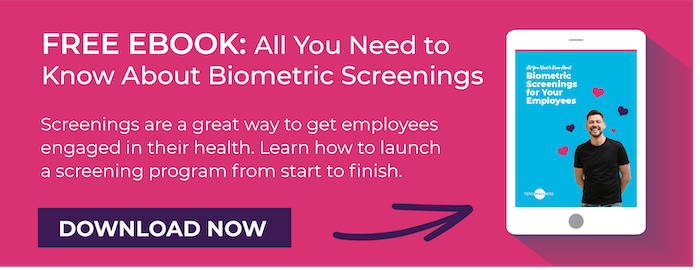![]() So you’ve done your biometric screening event. You did the organization, recruitment and it was a success! A few weeks later, you received your aggregate results. But now what?
So you’ve done your biometric screening event. You did the organization, recruitment and it was a success! A few weeks later, you received your aggregate results. But now what?
It can be difficult to decipher what your company’s screening results really mean. Even if you can figure out what they mean, do you know what do with that information?
The first step is always to dive into the aggregate results and look for trends. Some health conditions and complications can simply be hereditary. Others are caused by factors unrelated to the work environment.
That’s why looking for trends is important. Health trends in an aggregate report can illustrate a commonality among employees. Oftentimes, that common health struggle is impacted in some way by the environment in which your employees work. These health trends might be saying a little something about your company.
Here are four common wellness trends that you could see in your aggregate report.
Trend 1: High Blood Pressure
What it means: High blood pressure—or hypertension—can be common in a workplace. That’s because hypertension is often caused by prolonged stress. If your workforce clearly trends towards having high blood pressure, perhaps you have a consistently stressful corporate environment.
Prolonged stress and hypertension puts your employees at risk for a number of health complications. These include heart disease, stroke and even mental health struggles.
What you can do: You can address stress at your workplace to decrease collective blood pressure. Consider offering stress relief education or activities, using positive messaging in workplace interactions, or physically brightening up the office environment with friendly colors and natural light. All of these things can contribute to a low-stress workplace.
Trend 2: High Cholesterol
What it means: High cholesterol can be caused by a couple different things. It could mean that your employees struggle with either inactivity or an unhealthy diet. Living a sedentary lifestyle and eating fatty foods can both increase cholesterol.
High cholesterol is one of the major risk factors for heart disease, heart attacks and stroke because the cholesterol builds up in the blood stream and hinders efficient flow of blood.
What can you do: Addressing cholesterol at your workplace can happen in a couple different ways. To encourage an active lifestyle, you might invest in a worksite gym, walking meetings or even standing desks if the budget allows. To educate your employees about healthy eating, it might be helpful to provide healthy snacks, start a community garden or join a community supported agriculture program.
Trend 3: High BMI
What it means: BMI is a tricky health metric because it’s not always accurate. That’s because the measurement only takes into account height and weight. It doesn’t include things like body fat percentage or muscle mass. If you do see a trend towards high BMI, and it’s associated with some of the other negative health trends, it could mean your employees struggle with obesity. This simply means they’re not physically active enough to support the nutritional habits they have.
What you can do: The best way to address obesity among your workforce is to educate your employees on what it means to live a healthy lifestyle. Help them understand the different facets of their health—nutrition, physical activity, sleep, mental health. Positive steps in these areas can help to lower BMI and improve overall health.
Trend 4: Lower Blood Pressure, Cholesterol or BMI
What it means: You might compare your aggregate results with the same report from recent years and see a decrease in blood pressure, cholesterol or BMI. This means your employees are taking steps towards healthier lifestyles. While there are plenty of factors that go into the decision to focus on health, it could mean your wellness program is making a real impact!
What you can do: Keep up the good work! Do an audit of the wellness activities that seemed to have good engagement, and see how you can perfect those processes. If there were activities with poor engagement, swap them out with something new. Keep working hard, educating your workforce and investing in your employees’ health.
An aggregate report from your biometric screening can open your eyes to how your corporate environment affects your employees’ health. Be sure to dive into the aggregate report, look for trends and take action based on what you see.
How do you use your aggregate biometric screening results?



